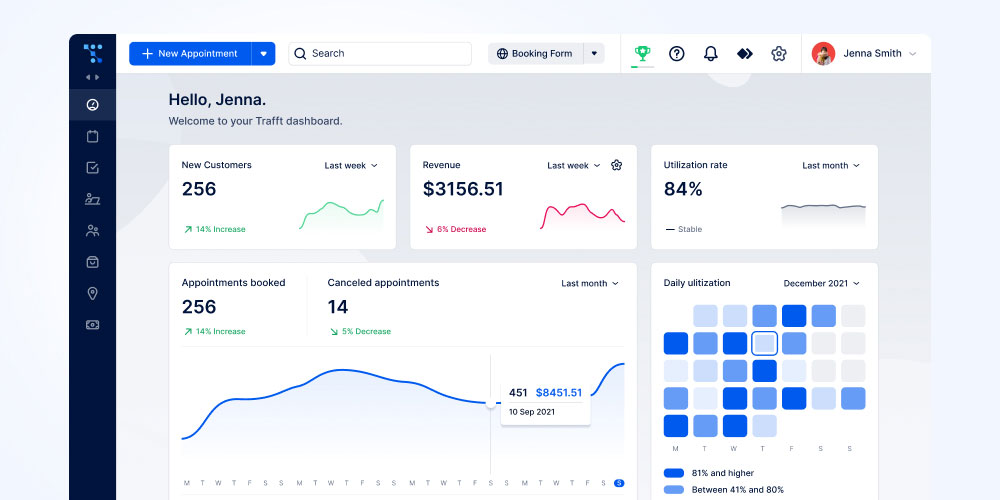If you’re thinking about starting a hair salon, it’s crucial to have a solid business plan in place. A hair salon business plan will help you make informed decisions and give you a clear roadmap to success. Plus, having a well-researched and detailed plan can help you secure funding from investors and grants.
In this guide, we’ll go over why having a hair salon business plan is so important and give you some tips for creating one that covers all the bases.
What to Keep in Mind Before Writing a Hair Salon Business Plan
When you’re planning to open your hair salon, there are a few important things to keep in mind to make sure everything goes smoothly. To ensure nothing gets forgotten or left out, download our step-by-step guide to opening a salon – you’ll have all the information you need in one place.
Now, let’s take a closer look at one of the most important factors to think about when writing your hair salon business plan:
Unlocking success: Uncovering your salon’s Unique Selling Proposition (USP)
Your salon’s unique selling proposition (USP) sets it apart and gives it a competitive edge. It’s the unique element that makes customers choose your salon over others. To identify your USP, ask yourself:
- What unique services or treatments do your salon offer?
- Do you specialize in a specific niche or cater to a particular target market?
- How do you provide an exceptional customer experience?
Boldly highlighting your USP in your hair salon business plan will attract attention and demonstrate your salon’s unique value proposition.
Investing wisely: Researching and budgeting for essential hair salon tools and equipment
Having the right tools and equipment to run a successful hair salon would be the most important. Each item plays a crucial role in delivering quality services.
Furniture: What theme will you have, and what setup do you need to get your salon started?
Business space: Renting vs. buying?
Staff: How many hairdressers do you need, and how much will their salary be?
Booking software: What booking software will you use to help automate the booking process?
Research the market, compare prices, and create a budget for acquiring your tools and equipment. Outlining your hair salon business plan’s estimated costs and specific equipment will showcase your preparedness and financial planning.
The client connection: Building and nurturing a loyal customer base
Keeping your customers happy is key to running a successful hair salon business. You can do this by offering personalized services, loyalty programs, and referral incentives. It’s also important to show your appreciation by giving special discounts and really listening to their needs.
Building trust with your customers is key to keeping them coming back. If you focus on providing exceptional service, you’ll have a loyal customer base in no time!
Beyond aesthetics: Designing a hair salon that blends style and function
When you’re putting together a business plan for your hair salon, remember to include a section about creating a cool and functional space.
The design and layout of your hair salon play a vital role in creating a welcoming and functional space. Consider the salon’s ambiance, layout efficiency, and comfort for clients and staff. You want it to look great, but also be practical for your team to work in and for clients to move around comfortably.
Make sure to cover all the important details and show that you’re prepared and strategic in your planning. And don’t forget to include an executive summary – this part is key for investors and lenders to get a quick overview of your hair salon business.
How to Write a Hair Salon Business Plan?
Every hair salon business plan should always include:
- Executive summary
- Company description
- Market analysis
- Competitor analysis
- Operation strategy
- Pricing
- Marketing plan
- Staffing and management structure
- Financial projections and budgeting
- Risk analysis and mitigation plan
Executive summary of the hair salon business plan
When you’re putting together a hair salon business plan, it’s a good idea to save your executive summary for the end. That way, you can include all the important details about your business. The executive summary is basically a big-picture overview that you’ll share with potential investors and lenders. You’ll want to include stuff like your goals, strategies for success and growth, financial projections, and an analysis of your competitive advantage. Anything that might catch the eye of a potential funding source should be in there.
For example, did you know that the global beauty market is worth a whopping $511 billion? And just last year, the Beauty and Personal Care industry brought in $564.40 billion in revenue. Experts think that the industry will keep growing at a rate of 4.76% per year from 2022 to 2026.
When you write your executive summary, it’s really important to show that your ideas are feasible and effective. A well-crafted summary can grab an investor’s attention by showing that you’ve done your homework and that your hair salon has real potential.
It’s also super important to write a great hair salon description. That’s your chance to make a great first impression and really show off what makes your hair salon special. Try to capture the essence of your hair salon in a way that really grabs people’s attention.
Painting a compelling hair salon description
When you’re describing your hair salon, start by giving the reader a feel for the place. Is it cozy and intimate or modern and trendy? Make sure to let them know about all the hair and beauty services you offer, especially any unique treatments or techniques you specialize in.
What makes your hair salon stand out? Maybe you have an amazing team of hair stylists who are passionate about what they do. Or maybe you use eco-friendly products that your clients love. Whatever it is, make sure to highlight those special qualities that make your hair salon one-of-a-kind.
Keep your description short and sweet, but make sure to get your message across. Let your excitement for your salon shine through in every word you write.
Market analysis, target market, and industry trends
Before opening your hair salon, it’s a good idea to figure out what your potential clients are looking for. Take a look at your competition and see what they’re offering – that way, you can find a way to stand out in the local market.
Don’t just think about age and gender when it comes to your target customers; you should also consider their interests and what motivates them. Knowing what makes them tick can help you create marketing messages that really speak to them.
If you’re not sure where to start with market analysis, Coursera has a great article that can give you some helpful tips.
To really set yourself apart from other hair salons in the area, it’s important to do a deep dive into your competition. Find out what they’re doing well and what they could improve on, and use that information to make your own hair salon even better.
Now comes the thinking part of analyzing the market and industry trends. This step is essential for your hair salon business plan. You want to understand who your ideal clients are so you can tailor your salon’s offerings and marketing strategies to their needs and desires.
Analyze your competition and how you can excel
When you’re checking out your competitors, don’t just glance at their website and social media pages. Take a deep dive into their customer reviews too, so you can really see how people feel about them. This will give you a better idea of their brand and what they’re doing well or not so well. Look for opportunities where you can stand out from the crowd by offering unique services or top-notch customer care.
It’s super important to keep on top of what’s happening in the beauty industry too. Keep your eyes peeled for new players and trends to stay ahead of the curve.
Operation strategy
Running a successful hair salon is all about being organized and efficient. This means hiring talented stylists, giving them the support they need through training and a positive work environment, using a reliable scheduling system, and keeping your inventory in check. Try to build strong relationships with your suppliers too, so you always have the supplies you need on hand.
Here’s how to optimize your operations and what aspects to include when writing your hair salon business plan:
Staffing and Training:
- Hire skilled hair stylists and provide comprehensive training.
- Foster a positive work environment for teamwork and motivation.
Appointment Management:
- Use a reliable scheduling system such as Trafft to minimize wait times.
- Utilize software for automated reminders and calendar management.
Inventory and Supplies:
- Maintain an organized inventory and restock as needed.
- Establish relationships with reliable suppliers.
Salon Maintenance:
- Keep the salon clean and maintain equipment.
- Pay attention to health and safety regulations.
Client Management:
- Provide exceptional service and track preferences.
- Collect and respond to client feedback.
Workflow Optimization:
- Streamline processes for maximum efficiency.
- Update workflows based on feedback.
Maintaining a competitive pricing
Developing the right pricing strategy is crucial for your hair salon’s financial success. Here’s how to create a hair salon pricing approach that maximizes profitability while staying competitive.
- Know your costs: Calculate all expenses, including rent, utilities, supplies, and staff wages, to determine the minimum price per service.
- Research the market: Analyze competitor pricing and industry standards. Consider your unique selling points and target market when setting prices.
- Tiered pricing: Offer different service packages at various price points to cater to different budgets and attract a broader customer base.
- Add-ons and upselling: Recommend additional services or products during client consultations to increase the value per transaction and boost revenue.
- Monitor and adjust: Regularly review your pricing strategy based on market trends, customer feedback, and financial goals. Make necessary adjustments to remain competitive and profitable.
By implementing a well-designed hair salon pricing strategy, your hair salon will cover costs, generate revenue, and deliver value to your customers.
Marketing and advertising plan
To create a winning hair salon marketing plan:
- Set clear marketing goals: increase brand awareness, drive foot traffic, and boost online bookings.
- Explore marketing channels: social media (Facebook, Instagram), local newspapers, and radio.
- Craft a compelling message: highlight unique selling points (exceptional customer service, talented stylists, latest trends).
- Embrace digital marketing: create a user-friendly website, showcase services, feature testimonials, and allow online bookings.
- Leverage social media: engage with the audience, share styling tips, and promote special offers.
- Consider partnerships: collaborate with local businesses, influencers, or complementary salons.
- Measure and track: monitor campaign success, track website analytics, and gather customer feedback.
- Optimize and refine: use data insights to improve marketing strategies over time.
- Position your hair salon as the go-to destination for hair styling services in your local market.
There are plenty of great hair salon marketing ideas you can put into practice to ensure your salon gets maximum exposure.
Staffing and management structure
Don’t forget to include details about employee and management structure in your hair salon business plan. For your hair salon to really take off, you need a strong leadership team to steer the ship. Look for people who have the right experience and know-how and are just as passionate about the salon biz as you are.
When you talk about your team, really hype up their qualifications and skills. Let people know about their deep knowledge of the industry and how they’re total pros at handling day-to-day operations. Be sure to explain their specific roles and how their expertise is going to help make sure your hair salon is running smoothly.
If your team members have some special training, like in hair reconstruction, definitely mention it. It’ll help set your salon apart and make it even more legit in people’s eyes.
Financial projections and budgeting
So, before you start your hair salon business, you need to figure out how much money you’re going to make. This includes everything from what services you’ll offer to how much you’ll charge. Take a look at what other salons in your area are doing and what your potential customers are willing to pay.
Next, you have to think about expenses. Rent, utilities, employee salaries, inventory, marketing, and other costs all add up. Make a list of everything and estimate how much they’ll cost you on a monthly or yearly basis.
One thing you don’t want to forget is your breakeven point. This is the number of services or products you need to sell to cover all your expenses. It’s important to know this so you can set realistic goals and measure your financial performance.
Creating a budget is key to having a solid financial plan. Think about where you want to put your money, like marketing, equipment upgrades, staff training, and supplies. Make sure you don’t overspend and stick to your budget.
Oh, and don’t forget about technology! Setting up a reliable booking system can make your life a lot easier and keep your clients happy. There are some great options out there, like Trafft. So, keep that in mind when you’re making your budget.
Why Trafft?
Let’s paint a picture: You’re opening a hair salon; your dream, finally taking shape. That’s thrilling, right? But hold on! It’s also daunting. The appointments, the management, the scheduling – it’s a tangled web.
Enter Trafft. It’s your new best friend, your invisible manager. Here’s why:
- 24/7 availability: Trafft handles your bookings, 24/7. Sleep easy knowing your customers can book anytime, from anywhere.
- No double-booking disasters: Trafft’s smart system prevents overlaps. Say goodbye to scheduling stress!
- Payments made painless: With integrated payment solutions, money matters are managed.
- Your salon, your rules: Fully customizable settings mean Trafft adapts to your salon, not the other way around.
Now imagine: A salon where you’re the stylist, not the secretary. Free from phone tag and double-bookings. A salon where customers conveniently book and pay, then arrive to a smooth, streamlined operation. That’s not just any salon. That’s a Trafft salon.
So why not turn your dream salon into a reality? Get Trafft. It’s not just software. It’s the helping hand your business deserves. Embrace the efficiency. Enjoy the ease. Experience Trafft. Your future self will thank you.
Risk analysis and mitigation plan
If you’re running a salon, you need to be aware of the potential risks that might come your way and tackle them head-on. These risks could be industry-specific or internal, like staff turnover or not complying with regulations. So, make sure to cover the details of how you plan to tackle these issues and include them in your hair salon business plan.
The plan could involve smart marketing or offering new services to deal with downturns, complying with regulations to avoid legal issues and negative feedback, and investing in staff training to make sure your clients are happy. And don’t forget to keep reviewing and updating your risk analysis and mitigation plan to stay on top of any challenges.
By being proactive and staying ahead of the game, you’ll be able to keep your salon business strong and overcome any obstacles that might come your way.
FAQ on Hair Salon Business Plan
What is a hair salon business plan?
A hair salon business plan is like a roadmap. It guides the direction and future of your business. It explains things like what services you’ll offer, who your customers are, and how you’ll make money. It’s basically your playbook for running the salon and attracting clients.
How important is a business plan for a hair salon?
Oh, it’s super crucial. Not having a plan is like driving with a blindfold on. It’s a tool to attract investors, secure loans, and understand your business better. You’ll be less likely to overlook important details, and you’ll have a clear vision to work towards.
What should a hair salon business plan include?
Your business plan should cover several key areas. Think of your services, target market, marketing plan, financial projections, and operational strategies. Also, don’t forget a solid competitive analysis. This way you know who you’re up against and can work to stand out.
How detailed should the hair salon business plan be?
Your business plan should be as detailed as possible. The more detailed, the better. It should cover everything from your business name, location, services, and pricing, to how you’ll advertise. Think about it as your salon’s blueprint.
How to do market research for a hair salon?
Start by looking at other salons in your area. What services do they offer? How much do they charge? Who are their clients? Online reviews and social media are good places to gather intel. Also, consider conducting surveys or focus groups to understand customer needs better.
How to calculate the financial projections for a hair salon?
First, you need to estimate your startup costs, like rent, equipment, supplies, etc. Then forecast your sales – how many clients will you serve daily, weekly, monthly? What will be the average spend per customer? Don’t forget about ongoing costs, like salaries, utilities, and marketing.
What are the funding options for starting a hair salon?
There are several ways to fund your salon. You can use personal savings, secure a bank loan, find investors, or even crowdfund. Each method has its pros and cons. It’s about finding what suits your situation best.
How to develop a marketing strategy for a hair salon?
Start by identifying your target clients. What social media platforms do they use? What magazines or blogs do they read? Tailor your marketing efforts to reach them. Consider loyalty programs, referral incentives, and special promotions. Remember, word-of-mouth can be super powerful in the beauty industry.
How to tackle competition in the hair salon business?
Differentiate yourself. Maybe it’s offering unique services, creating a distinctive salon experience, or focusing on superior customer service. Constantly keep an eye on what competitors are doing, but don’t just copy them. Build your own unique brand identity.
How to update a hair salon business plan?
Your business plan isn’t set in stone. As your salon evolves, so should your plan. Regularly review it, see what’s working and what’s not. Make adjustments as necessary. It’s a living document that grows with your business.
Final Thoughts on Creating an Effective Hair Salon Business Plan
Congratulations! You’ve reached the end of this ultimate guide to creating an effective hair salon business plan. Following the steps outlined in this guide, you have the knowledge and tools to write a comprehensive hair salon business plan that positions your salon for success.
Remember, a well-written plan is more than just a document. It’s a roadmap that guides your hair salon’s growth and is a valuable tool for attracting investors, lenders, and stakeholders.
Throughout this guide, we’ve explored essential elements such as understanding your target market, analyzing competition, developing a strategic marketing plan, establishing efficient operations, and setting a profitable pricing strategy. We’ve also emphasized the importance of financial planning, risk analysis, and creating a solid management team.
As you embark on your hair salon venture, stay focused on delivering exceptional customer service, staying abreast of industry trends, and continuously refining your strategies based on market feedback. With dedication, proper planning, and a passion for beauty and style, your hair salon can thrive in the competitive beauty industry.




